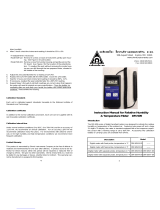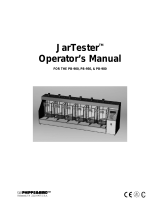YSI ProOBOD User manual
- Category
- Measuring, testing & control
- Type
- User manual
This manual is also suitable for
YSI ProOBOD measures dissolved oxygen in water using lifetime luminescence technology, eliminating sensor flow dependence, warm-up time, and frequent maintenance. It features a stirrer to keep solids from settling and quicken sensor response. Ideal for BOD and other applications requiring accurate DO readings in the laboratory.
YSI ProOBOD measures dissolved oxygen in water using lifetime luminescence technology, eliminating sensor flow dependence, warm-up time, and frequent maintenance. It features a stirrer to keep solids from settling and quicken sensor response. Ideal for BOD and other applications requiring accurate DO readings in the laboratory.













-
 1
1
-
 2
2
-
 3
3
-
 4
4
-
 5
5
-
 6
6
-
 7
7
-
 8
8
-
 9
9
-
 10
10
-
 11
11
-
 12
12
-
 13
13
YSI ProOBOD User manual
- Category
- Measuring, testing & control
- Type
- User manual
- This manual is also suitable for
YSI ProOBOD measures dissolved oxygen in water using lifetime luminescence technology, eliminating sensor flow dependence, warm-up time, and frequent maintenance. It features a stirrer to keep solids from settling and quicken sensor response. Ideal for BOD and other applications requiring accurate DO readings in the laboratory.
Ask a question and I''ll find the answer in the document
Finding information in a document is now easier with AI
Related papers
-
YSI 95 Dissolved Oxygen Meter Owner's manual
-
YSI MultiLab Wireless IDS WA System User manual
-
YSI 550A Owner's manual
-
YSI 50 Dissolved Oxygen Meter Owner's manual
-
YSI 55 Owner's manual
-
YSI Optical Dissolved Oxygen Sensor Cap User guide
-
YSI 51A Dissolved Oxygen Meter Owner's manual
-
YSI 50B Dissolved Oxygen Meter Owner's manual
-
YSI ProDSS User guide
-
YSI ProODO and ProSolo Comparison User guide
Other documents
-
TP-LINK TL-R402M V7 Declaration of conformity
-
Apera DO8032 User manual
-
Hanna Instruments HI98193 Owner's manual
-
Lovibond BD 600 User manual
-
Aqualytic OxiDirect BOD-System User manual
-
Fluke 971 Temperature Humidity Meter User manual
-
Hanna Instruments HI98198 Owner's manual
-
 Ohmic instruments DM-509-T-03 User manual
Ohmic instruments DM-509-T-03 User manual
-
Hach LBOD101 User manual
-
 Phipps & Bird JarTester PB-900 User manual
Phipps & Bird JarTester PB-900 User manual














